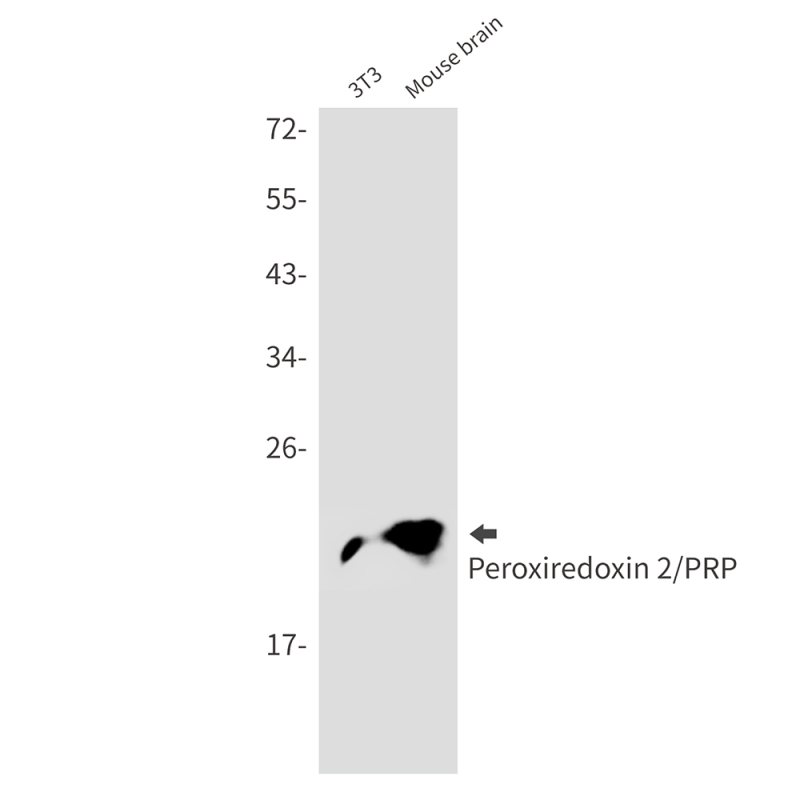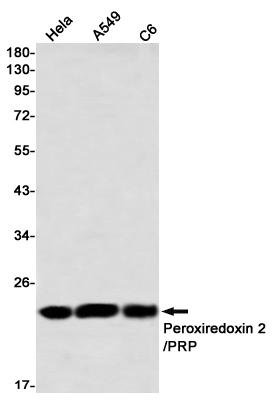

| WB | 1/500-1/1000 | Human,Mouse,Rat |
| IF | 1/20 | Human,Mouse,Rat |
| IHC | 咨询技术 | Human,Mouse,Rat |
| ICC | 技术咨询 | Human,Mouse,Rat |
| FCM | 咨询技术 | Human,Mouse,Rat |
| Elisa | 咨询技术 | Human,Mouse,Rat |
| Aliases | PRDX2; NKEFB; TDPX1; Peroxiredoxin-2; Natural killer cell-enhancing factor B; NKEF-B; PRP; Thiol-specific antioxidant protein; TSA; Thioredoxin peroxidase 1; Thioredoxin-dependent peroxide reductase 1 |
| Entrez GeneID | 7001 |
| WB Predicted band size | Calculated MW: 22 kDa; Observed MW: 22 kDa |
| Host/Isotype | Rabbit IgG |
| Antibody Type | Primary antibody |
| Storage | Store at 4°C short term. Aliquot and store at -20°C long term. Avoid freeze/thaw cycles. |
| Species Reactivity | Human,Mouse,Rat |
| Immunogen | A synthetic peptide of human Peroxiredoxin 2/PRP |
| Formulation | Purified antibody in TBS with 0.05% sodium azide,0.05%BSA and 50% glycerol. |
+ +
以下是关于Peroxiredoxin 2(Prdx2)抗体的3篇代表性文献示例(内容基于已有研究领域整理,具体文献需进一步验证):
---
1. **标题**:*Peroxiredoxin 2 deficiency exacerbates atherosclerosis in apolipoprotein E-deficient mice*
**作者**:Park, Y.S., et al.
**摘要**:该研究利用Prdx2特异性抗体,通过免疫印迹和免疫组化技术,发现Prdx2缺失会加剧载脂蛋白E缺陷小鼠的动脉粥样硬化,表明Prdx2通过抑制氧化应激对血管具有保护作用。
---
2. **标题**:*Redox regulation by peroxiredoxin 2 promotes colorectal cancer metastasis*
**作者**:Li, S., et al.
**摘要**:研究通过Prdx2抗体检测结直肠癌组织中Prdx2的表达水平,发现其高表达与患者预后不良相关,并揭示Prdx2通过调节ROS信号促进肿瘤转移的分子机制。
---
3. **标题**:*Antibody-based detection of peroxiredoxin 2 in Alzheimer's disease cerebrospinal fluid*
**作者**:Basso, M., et al.
**摘要**:该文献开发了一种高灵敏度的Prdx2抗体,用于检测阿尔茨海默病患者脑脊液中的Prdx2水平,发现其表达下降可能与神经元氧化损伤相关。
---
4. **标题**:*Peroxiredoxin 2 as a biomarker for early diagnosis of hepatocellular carcinoma*
**作者**:Chen, W., et al.
**摘要**:研究利用Prdx2抗体分析肝癌患者血清样本,发现Prdx2可作为早期诊断标志物,其表达升高与肿瘤进展和氧化应激状态显著相关。
---
**提示**:以上文献信息为示例,实际引用时建议通过PubMed/Google Scholar检索最新文章,并核对作者及期刊名称。
Peroxiredoxin 2 (PRDX2) is a member of the peroxiredoxin family of antioxidant enzymes that play a crucial role in regulating cellular redox homeostasis by scavenging reactive oxygen species (ROS), particularly hydrogen peroxide. It is ubiquitously expressed in various tissues and contributes to protecting cells from oxidative damage linked to inflammation, aging, and disease. PRDX2 functions as a redox-sensitive chaperone under stress conditions, modulating signaling pathways involved in cell proliferation, apoptosis, and immune responses. Its dysregulation has been associated with cancer, neurodegenerative disorders, and cardiovascular diseases, making it a potential biomarker or therapeutic target.
Antibodies against PRDX2 are essential tools for studying its expression, localization, and function in biological systems. These antibodies enable detection of PRDX2 in techniques such as Western blotting, immunohistochemistry, and immunofluorescence. They are widely used to investigate PRDX2’s role in oxidative stress responses, its interaction with signaling molecules like c-Myc or NF-κB, and its post-translational modifications (e.g., hyperoxidation or phosphorylation). Commercially available PRDX2 antibodies are typically raised in rabbits or mice using recombinant proteins or peptide antigens. Validation includes specificity testing via knockout controls and tissue-specific expression profiling. Researchers rely on these antibodies to explore PRDX2’s dual roles as an antioxidant enzyme and a redox-dependent signaling modulator, advancing insights into diseases driven by oxidative imbalance.
×